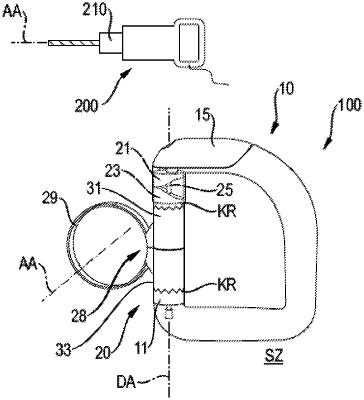| CPC B25F 5/026 (2013.01) | 21 Claims |

|
1. A side handle for an electric hand-held power tool, the side handle comprising:
a grip region designed to be gripped by a user; and
a clamp, the side handle releasably fastenable via the clamp to a machine neck of the hand-held power tool, the clamp having an operating element, the clamp movable between a clamped state and an unclamped state via the operating element, the operating element, when the clamp is in the clamped state, being flush with a surface of the grip region, the clamp having two clamping bodies in the form of cylinder portions, each oriented coaxially with a clamping screw, extending along an axis of rotation of the clamp, the two clamping bodies being formed in a complementary manner to one another so that the two clamping bodies rest against one another to extend along the axis with a first length in the unclamped state and with a second length in the clamped state, the second length being longer than the first length.
|